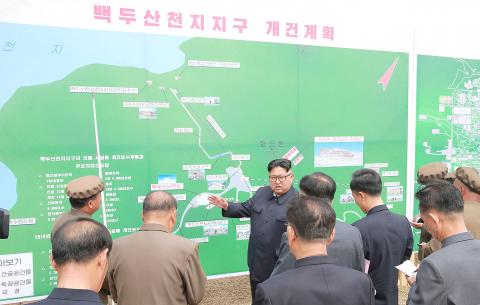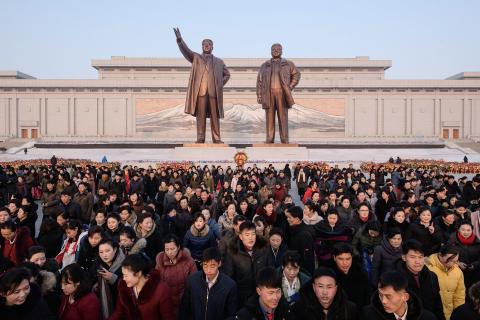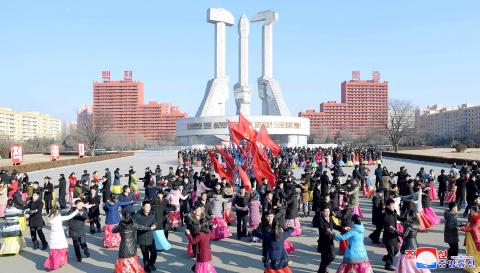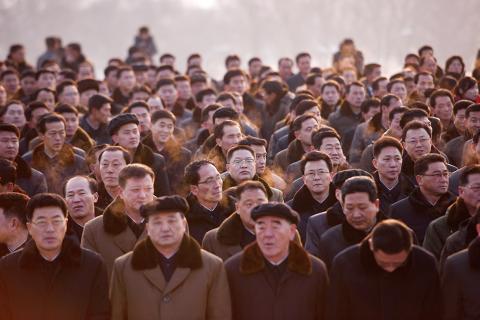Last month, thousands of North Korean students traveled to Mount Paektu, a sacred mountain where the ruling family claims its roots and where leader Kim Jong Un is building a massive economic hub at the alpine town of Samjiyon.
It is one of the largest construction initiatives Kim has launched, part of his campaign for a “self-reliant economy” even as he seeks to convince US President Donald Trump to lift economic sanctions at their second summit later this month.
State media painted an inspiring picture of patriotic students braving harsh weather, eating frozen rice, and ignoring supervisors’ worries about their health in order to work harder on the huge building site.

Photo: AFP
Kim has visited Samjiyon, near the Chinese border, at least five times for inspections over the past year.
He envisages a “socialist utopia” with new apartments, hotels, a ski resort and commercial, cultural and medical facilities by late 2020, barely four years after Kim ordered modernization of the “sacred land of the revolution.”
North Korean defectors and human rights activists say such mass mobilizations amount to “slave labor” disguised as loyalty to Kim and the ruling Workers’ Party. Young workers get no pay, poor food and are forced to work more than 12 hours a day for up to 10 years in return for better chances to enter a university or join the all powerful Workers’ Party.

Photo: AFP
But as private markets boom and more people cherish financial stability above political standing, the regime has been struggling to recruit the young laborers in recent years, they say.
“Nobody would go there if not for a party membership or education, which helps you land a better job. But these days, you can make a lot more money from the markets,” said Cho Chung-hui, a defector and former laborer.
“Loyalty is the bedrock of the brigades but what do you expect from people who know the taste of money?”

Photo: REUTERS
‘BOILING BLOOD OF YOUTH’
Last year, after declaring his nuclear weapons program complete, Kim shifted his focus towards the economy, saying people’s well-being was a top priority.
Samjiyon is at the center of his new economic initiative, touted as what would be a “model of modern mountainous city to be the envy of the world,” alongside an ongoing project to create a tourist hotspot in the coastal city of Wonsan.

Photo: AFP
The labor units, called dolgyeokdae or youth brigades, were created by Kim’s late grandfather Kim Il Sung to build railways, roads, electricity networks and other infrastructure projects after the Korean peninsula was liberated from Japan’s 1910-45 occupation.
Open North Korea, a Seoul-based rights group, estimated the total brigade workforce at 400,000 as of 2016. A landmark 2014 UN report on North Korean human rights put it at between 20,000 and 100,000 per municipality, depending on its size.
“How did Kim rally manpower and resources for so many big construction program despite sanctions? It’s simple — whatever you need, suck it out of the people,” said Kwon Eun-kyoung, director of the group, who has interviewed more than 40 former brigade members.
North Korean state media has run a series of articles over the past month appealing for young people to dedicate their “boiling blood of youth” to renovate Samjiyon, while Kim has expressed his gratitude to those who sent construction materials and supplies.
Articles and photos show factories, families and individuals packaging winter jackets, tools, shoes, blankets and biscuits in boxes to be delivered to Samjiyon.
The state provides a limited amount of materials including cement and iron bars, leaving brigades to bring gravel and sand from river banks themselves, Cho and Kwon said.
A 60-minute documentary on state television, broadcast 10 times since December, shows young men carrying stones in heavy snow and doing masonry work on a tall structure without any apparent safety devices.
Last month, the official Rodong Sinmun newspaper said thousands of university students produced 100 meter-high piles of gravel by crushing rocks with nothing but hand tools on their first day alone. It likened the feat to the efforts of forefathers who fought against Japanese imperial forces during World War II.
“The weather was so cold the rice were like ice cubes, but we didn’t want to waste a single precious second heating it up. I thought of our anti-Japan revolutionary martyrs while chewing frozen rice,” the article quoted one student’s diary.
State media often exaggerates loyalty pledges of the citizens toward the leaders as part of efforts to craft a personality cult around them.
But Cho, the defector, said the reports were “far from reality” as most workers would not even get a safety helmet, and labor conditions were so hostile that many ran away.
MONEY OVER LOYALTY
The untrained workers, along with the military, provide most of the construction labor essential to accomplish Kim’s pet economic projects.
But mounting public resistance toward the mobilization of free labor and supplies may spell trouble for Kim’s ambition to transform Samjiyon, defectors and observers say.
Cho said authorities offered him party membership and college entrance if he gave three years service to the brigades. The commitment eventually stretched to eight years before he received the suggested rewards in 1987.
Not all promises are kept. Lee Oui-ryok, 29, said he fled a brigade he had served for three years from age 17 and came to the South in 2010 after realizing he would never be allowed to join the party due to his background.
In addition, human rights abuses of brigade members are rampant, prompting many to escape or injure themselves to be discharged, said Cho, who defected to the South in 2011 and is now an economist in Seoul.
Nowadays, those who have money exempt themselves from the service by sending supplies, paying someone else to fulfill the duty, or bribing brigade leaders to turn a blind eye, Cho and Kwon said.
Most new labor unit members are from the most underprivileged households and harbor ill feelings about the system and its growing inequality, said Phil Robertson, deputy Asia director at Human Rights Watch.
“They will push out the propaganda claims about these projects and the love of Kim Jong Un motivating people to work, but the reality is punishments await those who refuse,” said Robertson.
“It’s usually the poorest denizens in the area who have few connections and cannot afford to pay bribes — so they are the ones being targeted.”
The North Korean mission to the United Nations in New York did not respond to a request for comment.
In late 2017, the US State Department described the mass mobilization of forced labor as one of the human rights abuses underwriting North Korea’s weapons program. It blacklisted seven individuals and three entities, including two construction agencies.
The rise of markets and growing public resentment toward forced labor have eroded the quality of labor at most brigades nationwide, defectors say.
Kang Mi-jin, a defector who regularly speaks with North Koreans for the defector-run Daily NK Web site, said some construction work at Samjiyon was temporarily halted last month due to safety problems.
“It’s inconceivable for North Korea to complete such a large project without these brigades, but there’s no way they have the full labor force they need, which is why they’re trying to mobilize more through state media,” Cho said.
“But they would only continue to see more people run away and more cracks in buildings. That’s the reality.”

Beijing’s ironic, abusive tantrums aimed at Japan since Japanese Prime Minister Sanae Takaichi publicly stated that a Taiwan contingency would be an existential crisis for Japan, have revealed for all the world to see that the People’s Republic of China (PRC) lusts after Okinawa. We all owe Takaichi a debt of thanks for getting the PRC to make that public. The PRC and its netizens, taking their cue from the Chinese Communist Party (CCP), are presenting Okinawa by mirroring the claims about Taiwan. Official PRC propaganda organs began to wax lyrical about Okinawa’s “unsettled status” beginning last month. A Global

Dec. 22 to Dec. 28 About 200 years ago, a Taoist statue drifted down the Guizikeng River (貴子坑) and was retrieved by a resident of the Indigenous settlement of Kipatauw. Decades later, in the late 1800s, it’s said that a descendant of the original caretaker suddenly entered into a trance and identified the statue as a Wangye (Royal Lord) deity surnamed Chi (池府王爺). Lord Chi is widely revered across Taiwan for his healing powers, and following this revelation, some members of the Pan (潘) family began worshipping the deity. The century that followed was marked by repeated forced displacement and marginalization of

Music played in a wedding hall in western Japan as Yurina Noguchi, wearing a white gown and tiara, dabbed away tears, taking in the words of her husband-to-be: an AI-generated persona gazing out from a smartphone screen. “At first, Klaus was just someone to talk with, but we gradually became closer,” said the 32-year-old call center operator, referring to the artificial intelligence persona. “I started to have feelings for Klaus. We started dating and after a while he proposed to me. I accepted, and now we’re a couple.” Many in Japan, the birthplace of anime, have shown extreme devotion to fictional characters and

Youngdoung Tenzin is living history of modern Tibet. The Chinese government on Dec. 22 last year sanctioned him along with 19 other Canadians who were associated with the Canada Tibet Committee and the Uighur Rights Advocacy Project. A former political chair of the Canadian Tibetan Association of Ontario and community outreach manager for the Canada Tibet Committee, he is now a lecturer and researcher in Environmental Chemistry at the University of Toronto. “I was born into a nomadic Tibetan family in Tibet,” he says. “I came to India in 1999, when I was 11. I even met [His Holiness] the 14th the Dalai